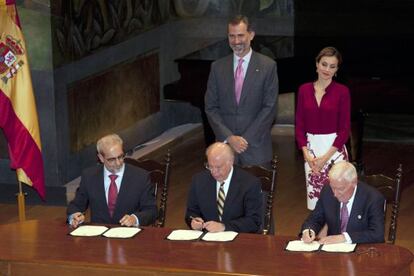A single Spanish language proficiency certificate for the whole planet
Spain’s King Felipe presents new test for determining students’ levels, wherever they are


Students of a foreign language usually have a globally recognized test that they can take to demonstrate their skill level: English has its Cambridge-awarded Proficiency, French has its DALF, German has its Goethe-Zertifikat... But not so Spanish.
There are 550 million Spanish speakers in the world, yet no international examination to certify proficiency in the language exists.
But this shortcoming is about to end. Within the hallowed walls of the San Ildefonso College in Mexico City on Tuesday, Spain’s King Felipe VI and Queen Letizia presided the presentation of Siele – the International Service for Evaluation of the Spanish Language.
If we want to reaffirm Spanish as the world’s second language, we have to move beyond a short-term, self-absorbed vision”
King Felipe VI
This test will determine a student’s Spanish skills, and can be administered practically anywhere on the planet.
The examination has a pan-Hispanic approach, bringing together the varied forms of the language in use in different Spanish-speaking countries. By doing so, it hopes to become a globally recognized language certificate.
The initiative was jointly developed by Spain’s Cervantes Institute, which has 90 centers in 44 countries, by the National Autonomous University of Mexico and by the University of Salamanca, which are, respectively, the largest and the oldest centers of higher learning in the Spanish-speaking world.
The test will first be administered at the beginning of the next academic year, and forecasts are talking about a minimum of 300,000 candidates annually, growing to 750,000 in five years.
“We were missing a flexible, highly respected certificate of proficiency in Spanish as a foreign language along the lines of those offered for the English language,” said King Felipe in his speech.
The new certificate will be available on five continents, but the greatest effort will be focused, until 2018 at least, on three countries: Brazil, with 120 test centers, the United States with 100, and China with 60. More than 15 million people are currently studying Spanish in those three countries alone.
The Siele will have four sections: reading, listening, writing and oral expression. The candidates’ efforts will be evaluated by accredited experts, and applicants may choose whether to take all sections at the same time or to break them up. Results will be available within three weeks of taking the examination.
Successful candidates will receive a certificate with a two-year expiration date.
The test is part of a broader project aimed at advancing Spanish-language education in all of its diversity.
“The Siele is not just an evaluation, it is also a way to promote Spanish, and by that we mean everyone’s Spanish, with everyone on an equal footing,” said the head of the Cervantes Institute, Víctor García de la Concha. “We want all 900 Ibero-American universities and all education ministries to participate in this project.”
“If we want our language to reaffirm itself as the world’s second language of communication, we have to move beyond a short-term, self-absorbed vision and pool everyone’s resources to achieve a goal that will benefit us all,” added the Spanish monarch.
The event formed part of the king and queen’s official visit to Mexico, where they championed the Spanish language as an engine of growth for the entire Spanish-speaking world.
Tu suscripción se está usando en otro dispositivo
¿Quieres añadir otro usuario a tu suscripción?
Si continúas leyendo en este dispositivo, no se podrá leer en el otro.
FlechaTu suscripción se está usando en otro dispositivo y solo puedes acceder a EL PAÍS desde un dispositivo a la vez.
Si quieres compartir tu cuenta, cambia tu suscripción a la modalidad Premium, así podrás añadir otro usuario. Cada uno accederá con su propia cuenta de email, lo que os permitirá personalizar vuestra experiencia en EL PAÍS.
¿Tienes una suscripción de empresa? Accede aquí para contratar más cuentas.
En el caso de no saber quién está usando tu cuenta, te recomendamos cambiar tu contraseña aquí.
Si decides continuar compartiendo tu cuenta, este mensaje se mostrará en tu dispositivo y en el de la otra persona que está usando tu cuenta de forma indefinida, afectando a tu experiencia de lectura. Puedes consultar aquí los términos y condiciones de la suscripción digital.
More information
Últimas noticias
The complicated life of Francesca Albanese: A rising figure in Italy but barred from every bank by Trump’s sanctions
How Japan is trying to avert ‘digital defeat’
Half of Scotland is in the hands of 420 property owners
Reinhard Genzel, Nobel laureate in physics: ‘One-minute videos will never give you the truth’
Most viewed
- Pablo Escobar’s hippos: A serious environmental problem, 40 years on
- Why we lost the habit of sleeping in two segments and how that changed our sense of time
- Charles Dubouloz, mountaineering star, retires at 36 with a farewell tour inspired by Walter Bonatti
- Reinhard Genzel, Nobel laureate in physics: ‘One-minute videos will never give you the truth’
- The Florida Keys tourist paradise is besieged by immigration agents: ‘We’ve never seen anything like this’









































